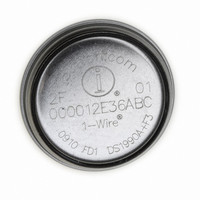DS1972-F3+ Maxim Integrated Products, DS1972-F3+ Datasheet - Page 8

DS1972-F3+
Manufacturer Part Number
DS1972-F3+
Description
IBUTTON EEPROM 1KBit F3
Manufacturer
Maxim Integrated Products
Series
iButton®r
Datasheet
1.DS1972-F3.pdf
(23 pages)
Specifications of DS1972-F3+
Rohs Information
IButton RoHS Compliance Plan
Memory Size
128B
Memory Type
EEPROM
Lead Free Status / RoHS Status
Lead free / RoHS Compliant
1024-Bit EEPROM iButton
The protection-control registers determine how incom-
ing data on a Write Scratchpad command is loaded
into the scratchpad. A protection setting of 55h (write
protect) causes the incoming data to be ignored and
the target address main memory data to be loaded into
the scratchpad. A protection setting of AAh (EPROM
mode) causes the logical AND of incoming data and
target address main memory data to be loaded into the
scratchpad. Any other protection-control register set-
ting leaves the associated memory page open for unre-
stricted write access. Protection-control byte settings of
55h or AAh also write protect the protection-control
byte. The protection-control byte setting of 55h does
not block the copy. This allows write-protected data to
be refreshed (i.e., reprogrammed with the current data)
in the device.
The copy-protection byte is used for a higher level of
security and should only be used after all other protec-
tion-control bytes, user bytes, and write-protected
pages are set to their final value. If the copy-protection
byte is set to 55h or AAh, all copy attempts to the regis-
ter row and user-byte row are blocked. In addition, all
copy attempts to write-protected main memory pages
(i.e., refresh) are blocked.
The DS1972 employs three address registers: TA1, TA2,
and E/S (Figure 6). These registers are common to many
other 1-Wire devices but operate slightly differently with
the DS1972. Registers TA1 and TA2 must be loaded with
Figure 6. Address Registers
8
_______________________________________________________________________________________
Address Registers and Transfer Status
TARGET ADDRESS (TA1)
TARGET ADDRESS (TA2)
ENDING ADDRESS WITH
DATA STATUS (E/S)
(READ ONLY)
BIT #
T15
AA
T7
7
T14
T6
6
0
T13
T5
PF
5
the target address to which the data is written or from
which data is read. Register E/S is a read-only transfer-
status register used to verify data integrity with write
commands. E/S bits E[2:0] are loaded with the incoming
T[2:0] on a Write Scratchpad command and increment
on each subsequent data byte. This is, in effect, a byte-
ending offset counter within the 8-byte scratchpad. Bit 5
of the E/S register, called PF, is a logic 1 if the data in the
scratchpad is not valid due to a loss of power or if the
master sends fewer bytes than needed to reach the end
of the scratchpad. For a valid write to the scratchpad,
T[2:0] must be 0 and the master must have sent 8 data
bytes. Bits 3, 4, and 6 have no function; they always read
0. The highest valued bit of the E/S register, called
authorization accepted (AA), acts as a flag to indicate
that the data stored in the scratchpad has already been
copied to the target memory address. Writing data to the
scratchpad clears this flag.
To write data to the DS1972, the scratchpad must be
used as intermediate storage. First, the master issues
the Write Scratchpad command to specify the desired
target address, followed by the data to be written to the
scratchpad. Note that Copy Scratchpad commands
must be performed on 8-byte boundaries, i.e., the three
LSBs of the target address (T2, T1, T0) must be equal
to 000b. If T[2:0] are sent with nonzero values, the copy
function is blocked. Under certain conditions (see the
Write Scratchpad [0Fh] section) the master receives an
T12
T4
4
0
T11
T3
3
0
T10
T2
E2
2
Writing with Verification
T1
T9
E1
1
T0
T8
E0
0













